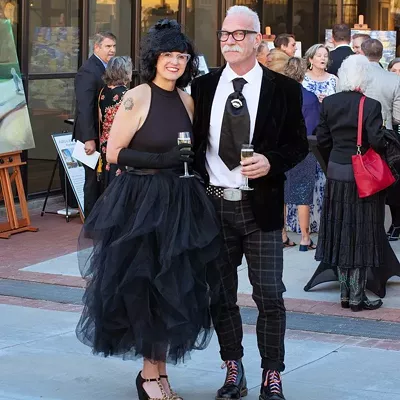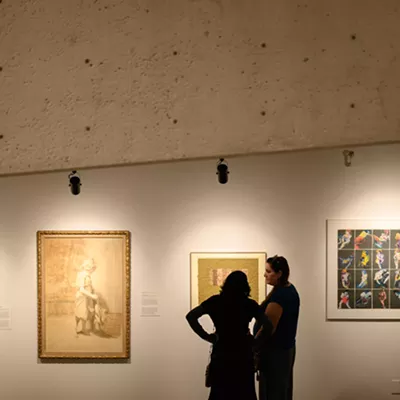Santo Niño de Atocha, patron saint of migrants traveling the desert today, has long been on a journey of his own.
It started as early as the 13th century, in Spain.
Equipped with a pilgrim's cape, a hat, walking stick and a basket of food, the Santo Niño—the Holy Child Jesus—was believed to roam the hills around Toledo by night, bringing food to Christians imprisoned in Muslim jails. In the morning, he would return to his sculptural perch in a church, rejoining his mother, the Virgin Mary. The devout could see that the sculpted child's feet were dirty and his clothes rumpled after his nighttime missions of mercy.
And when the Spaniards went to the New World, el Niño traveled right along with them. Before long, says Michael Brescia, lead curator of the sumptuous show "Intimacy of Faith" at the Arizona State Museum, Santo Niño had become the patron saint of silver miners; a shrine was built to him in the mining region Zacatecas, Mexico, in 1554. Whenever a mine collapsed, Santo Niño would slip the bounds of his painted image to bring water to the trapped miners and lead them to safety.
Nowadays, in the borderlands, the Holy Child is venerated by migrants "trying to cross safely," Brescia notes. Holy cards of the Niño, still dressed in the traveling clothes he wore in Spain centuries ago, regularly turn up on migrant trails and shrines in the desert.
Images of Santo Niño de Atocha—and the Virgen of Guadalupe and whole choirs of saints—abound in "Intimacy of Faith," a fascinating exhibition of some 300 works of Mexican popular art. "Intimacy" shows the persistence of religious belief—and its adaptation to changing circumstances. Drawn from the Giffords family collection and guest-curated by Gloria Fraser Giffords, it features small-scale "retablos"—paintings of popular saints—and "ex-votos," personal paintings commissioned by the devout to express gratitude for favors received from a heavenly patron.
The charming ex-votos (Latin for "from the vow") are mostly 19th and 20th century works, painted on tin by self-taught artists. Typically they depict a disaster and a happy ending engineered by a saint; they nearly always include a painted image of the grateful recipient of the life-saving intervention. The story is told in a text painted at the bottom.
In 1879, for example, Pedro Tovar believed he was saved from drowning by the grace of Nuestro Señor de Sacromonte. In a painting composed to fulfill his vow to give thanks, poor Pedro is flailing in a rushing river, along with his horse and a couple of his cows. His distraught neighbors run helplessly along the banks. Luckily, Jesus—Our Lord of the Sacred Hill—appears above, lying in a casket, having been summoned by Pedro's prayers.
Elsewhere in these tiny paintings, a boy named Anacleto survives five bites from a rabid dog. Filofilo Laredo's husband is delivered from a dangerous pneumonia, thanks to Our Lord of Anguishes (Christ on the cross). The unfortunate husband is shown in bed, coughing up a stream of blood. And the busy Santo Niño de Atocha rescues a traveler from armed bandits in a forest.
In the 20th century, the dangers needing intervention evolved. A man is pinned beneath a steamroller on a country road in one ex-voto but, providentially, the Three Kings have come to his rescue, floating in via the sky above. The grateful man, who was almost crushed to death, praises the Kings, who "sent me my health after a grave accident." The artist had some fun too, placing the scene within a lovely landscape of distant blue mountains and rolling green hills.
These popular works, says Brescia, a historian of Mexico who also serves as the museum's associate director, trace their roots far back into history. The word retablo (from the Latin from "behind the altar"), once referred exclusively to the large-scale, official paintings erected behind the altar in cathedrals in Europe and later in the Americas. But after the Protestant Reformation, with the Catholic Church eager to re-ignite the faith, the authorities encouraged small works that could be taken into the home and used in daily devotions.
And in Mexico, after Independence in 1821, anti-clerical sentiment grew; the trend toward religious practices in the home only increased.
As a result, these retablos and ex-votos "provide us with personal and intimate glimpses into the daily religious lives of Mexicans in the 19th and 20th centuries," Brescia says.
Personal is right. In a 1961 ex-voto, a man in Zacatecas has been rescued from gas pains inflicted by drinking a bottle of Coca-Cola. The artist took the opportunity to create an engaging streetscape, with adobe houses lined up on a slanting street and a typical tienda front and center. Outside the store is the offending red Coca-Cola cooler and the man, not yet stricken, is guzzling down a bottle of Coke.
But when the gas pains arrive, he kneels and prays to the saint he knows will travel to help him: his local patron saint, Santo Niño de los Plateros, the Holy Child of the Miners, otherwise known as Santo Niño de Atocha.











